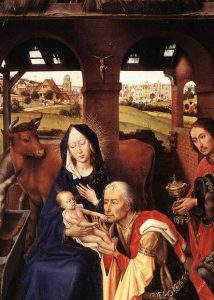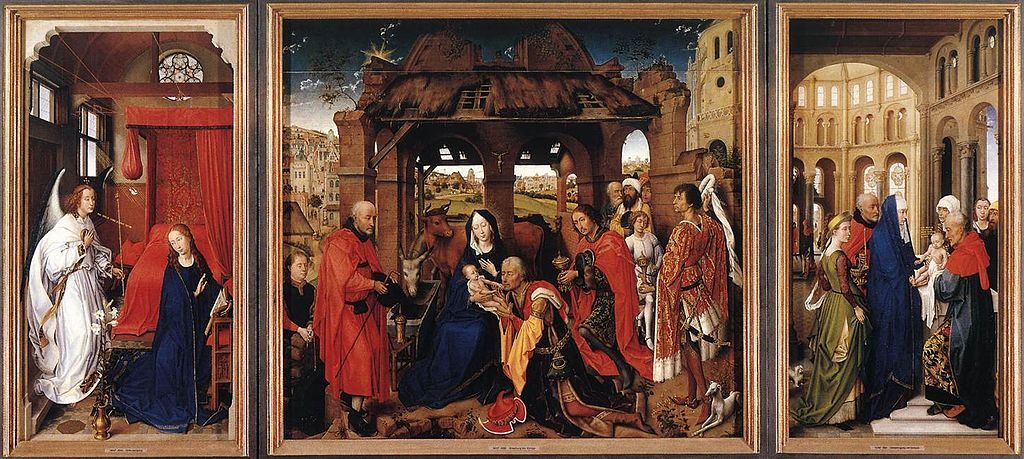I’m heartened to see more and more Christians keeping Advent—not rushing to the feast, but spending time in holy expectation. The historian in me approves. When we observe Advent, we deepen our preparation for Christ’s coming by embracing the liturgical rhythms of the ancient Church. Some historical Advent practices, such as fasting, many of us do not keep today. Others, like the annual Christmas pageant, are still going strong (in the medieval Church the pageant was performed by choirboys).
This year, as I watch my daughters perform one of their own practices, I’ve been drawn to some wonderful medieval teachings on Advent. Perhaps I should say Advents. In one of his sermons for the season, written in the mid twelfth century, Bernard of Clairvaux speaks of not one but three comings of Christ. A century later, Thomas Aquinas adds yet another. That’s three more comings than most of us prepare for. It has taken my two children to help me absorb what these four advents might mean for me.
***
Christ’s first coming, no surprise here, is his historical advent. My daughters have developed an elaborate practice to prepare for this event: the manger scene. My girls set up their scene with the precision of an HGTV reality show. Everything must be just so. The picture on the box is consulted: Mary must stand here, Joseph there. The manger must be centered. Then and only then is the baby tenderly placed therein. But not for long; Jesus requires much more attention than that. He is taken out and taken care of, cradled and coddled until it is deemed the right time to lay him down again. I sometimes think God sent his son as a baby for the benefit of maternally inclined five-year-olds.
My girls’ mothering reminds me of a beautiful fourteenth-century devotional text, Meditations on the Life of Christ. In this text, readers are asked to imagine their way into the manger scene: “Kiss the beautiful little feet of the infant Jesus who lies in the manger and beg his mother to let you hold him a while.” Later, we are advised to step in and help Mary: “Be ready to give your services as if you could, meditate on them, delight and rejoice in them . . . and often gaze upon that face which angels desire to look upon.” Caring, with all our imaginative and spiritual faculties, for the baby Jesus: what a wonderful meditational exercise for the Advent season. I wonder if the infant Jesus slept through the night?
This exercise leads to another, perhaps deeper, form of preparation. In his sermon, Saint Bernard notes that Jesus not only came in the flesh. He also comes to our heart. He is hidden there: “Only his chosen see him in themselves, and they shall heal their souls.” I like to think of Jesus’ indwelling in us as a continuation of Mary’s work. Mary gave birth to Jesus and cared for him physically. Now it is our job to spiritually receive Christ and raise him up. He must grow to maturity in our heart.
My daughters pick baby Jesus up and put him down. They take him to town. They sing to him. Watching them play reminds me how much care Jesus needs to grow in me. It makes my heart tender but also afraid. I feel keenly my own lack. Sometimes I fail to care for my children the way I should. How can I possibly provide for Jesus? I need not only the baby but also the savior. My yearning for Christ’s grace is as great as my desire to cradle him in my heart.
 Of course we know that Jesus’ cradle leads to the cross and the grace we so desperately need. These two yearnings are depicted in one of my favorite paintings, the Adoration of the Magi by the Flemish artist Rogier van der Weyden. As one of the kings leans forward to kiss the infant Jesus, almost exactly as recommended by the Meditations on the Life of Christ, we see a small crucifix nailed to a post above his head. It is a good painting for Advent because it keeps us from sentimentalizing the birth of Christ. If you want to grow up the baby Jesus, remind yourself that he’s headed to the cross. That will do it every time.
Of course we know that Jesus’ cradle leads to the cross and the grace we so desperately need. These two yearnings are depicted in one of my favorite paintings, the Adoration of the Magi by the Flemish artist Rogier van der Weyden. As one of the kings leans forward to kiss the infant Jesus, almost exactly as recommended by the Meditations on the Life of Christ, we see a small crucifix nailed to a post above his head. It is a good painting for Advent because it keeps us from sentimentalizing the birth of Christ. If you want to grow up the baby Jesus, remind yourself that he’s headed to the cross. That will do it every time.
But Advent looks even farther ahead in the life of Christ. In his sermon, Bernard of Clairvaux reminds the Church that within Christ’s coming in the flesh is embedded the promise of his coming again. Jesus will return to earth, and the world will be made new. We are assured that whatever darkness surrounds us, God will bring his story to the glorious conclusion he foretold.
As we reflect on the teaching of the Mellifluous Doctor, we realize that Advent is truly ancient-future. It harks back to the birth of Jesus (and before that to the prophecies about him). It takes place in the present as he is born in our heart. And it looks forward to the end of earthly time. Advent is a season to meditate on the entire history of salvation through Jesus Christ, a season to both celebrate and yearn for the world’s redemption.
Admittedly, my girls seem far more earthly than eschatological when they play with their manger scene. “He doesn’t want his blanket.” “Yes, he does! All babies need their blanket!” But as Saint Bernard shows, the birth of Jesus is wrapped up in his other advents, even the ones that are invisible or that take place in a distant future. Christ’s comings cannot be separated one from another; one form of yearning leads to the next. It is strange to watch my daughters play and feel so much ache mixed in with my delight. When my girls are older I will tell them about the complex theology behind their childlike faith.
I could end my Advent meditation here. Bernard of Clairvaux does. His sermon, as I mentioned, teaches three comings of Christ—in the flesh, in our hearts, and at the end of time. But in an Advent sermon preached in 1271, Thomas Aquinas adds a fourth coming of Jesus. Christ comes, writes the Angelic Doctor, at the hour of our death. This coming is necessary to bring his “just ones” not only grace, but also glory.
I confess that with this teaching, my yearning grinds to a halt. It seems easier to long for the end times than for my personal end. Yet Saint Thomas is not the only one to advise me on this subject. Centuries earlier, the desert father Pachomius said, “Have, therefore, the hour of your death ever before your eyes.” Even in Advent? Even when my children are so full of life and the whole world is telling me to be joyful? Upon reflection, I conclude that there is no better time. During this season, we prepare for a savior who came to defeat death—yes, even our own. When he comes for us, it will be to take us to glory.
And so, as I watch over my children, I learn to watch my heart. I coax and guide it to think on its final hour. If I can’t yet yearn for this coming of Christ, I can at least be alert. I ask my heart, are you ready? Christ will return for you one day, and this advent is every bit as real as his birth in the flesh and his coming again.
Thanks to two daughters and two doctors of the church, my Advent preparations are a strangely medieval mix of delight, yearning, and rather intense soul-searching. As a mother, I look for the coming of a baby, one as fleshy and sweet as my girls. I also remember that the baby Jesus grew up to save the world and that he will come again, both at the end of time and, likely before that, for me. May my heart be prepared to mother him now and to meet him when my time comes.
Sources
Bernard of Clairvaux: Sermons for Advent and for the Christmas Season. Trans. Irene Edmonds, Wendy Mary Beckett, and Conrad Greenia OCSO. Ed. John Leinenweber. Kalamazoo, MI: Cistercian Publications, 2007, pp. 33-35.
Hahn-Hahn, Ida. Fathers of the Desert. 1907. Reprint. London: Forgotten Books, 2013, pp. 198-9.
